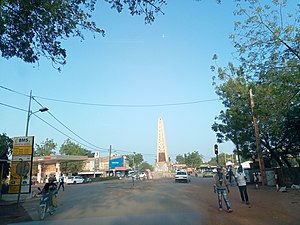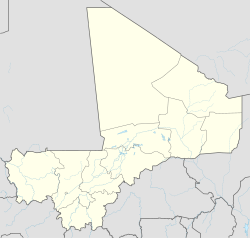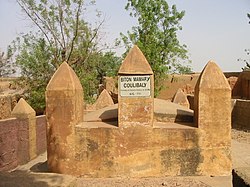
The Bambara are a Mandé ethnic group native to much of West Africa, primarily southern Mali, Ghana, Guinea, Burkina Faso and Senegal. They have been associated with the historic Bambara Empire. Today, they make up the largest Mandé ethnic group in Mali, with 80% of the population speaking the Bambara language, regardless of ethnicity.

Mopti is the fifth administrative region of Mali, covering 79,017 km2. Its capital is the city of Mopti. During the 2012 Northern Mali conflict, the frontier between Southern Mali which is controlled by the central government and the rebel-held North ran through Mopti Region.
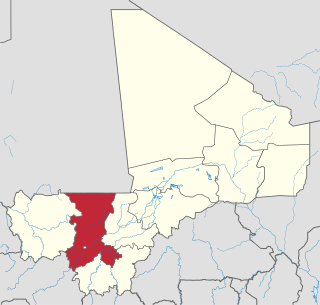
Koulikoro Region is a region in western Mali. It is the second administrative area of Mali and covers an area of 90,120 km2. Its capital is the city of Koulikoro.

Ségou Region is an administrative region in Mali, situated in the centre of the country with an area of 64,821 km2 (25,028 sq mi), around 5% of Mali. The region is bordered by Sikasso Region on the south, Tombouctou and Mopti on the east, Burkina Faso to the southeast and the Koulikoro Region to the west. In 2009 it had 2,336,255 inhabitants, making it the second most populous region of Mali. Its administrative capital is the town of Ségou.
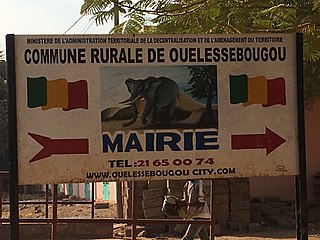
Mali is a multilingual country of about 21.9 million people. The languages spoken there reflect ancient settlement patterns, migrations, and its long history. Ethnologue counts more than 80 languages. Of these, Bambara, Bobo, Bozo, Dogon, Fula, Arabic, Kassonke, Maninke, Minyanka, Senufo, Songhay languages, Soninke and Tamasheq are official languages.
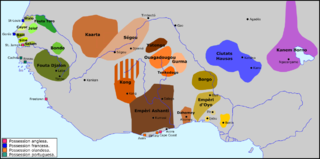
The Bamana Empire was one of the largest states of West Africa in the 18th century. Along with Kaarta it was one of the most important successors of the Songhai Empire. Based on an earlier kingdom established in 1640, it grew into a powerful empire in the early 18th century under Bitòn Coulibaly. The empire existed as a centralized state from 1712 until the 1861 invasion by the Toucouleur conqueror El Hadj Umar Tall.
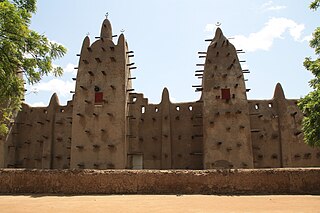
San is an urban commune, town and capital of the Cercle of San in the Ségou Region of Mali. The town lies 10 kilometres or 6 miles south of the Bani River. In the 2009 census the commune had a population of 68,078.

The Soninke (Sarakolleh) people are a West African Mande-speaking ethnic group found in Mali, southern Mauritania, eastern Senegal, The Gambia, and Guinea. They speak the Soninke language, also called the Serakhulle or Azer language, which is one of the Mande languages. Soninke people were the founders of the ancient empire of Ghana or Wagadou c. 200–1240 CE, Subgroups of Soninke include the Jakhanke, Maraka and Wangara. When the Ghana empire was destroyed, the resulting diaspora brought Soninkes to Mali, Mauritania, Senegal, Gambia, Burkina Faso, Côte d'Ivoire, Guinée-Conakry, modern-day Republic of Ghana, Kano in Nigeria, and Guinea-Bissau where some of this trading diaspora was called Wangara, leading to the saying “when Americans landed on the moon, a Soninke was already there” in Senegal, with other versions across West Africa.

Hadji Oumarûl Foutiyou Tall, born in Futa Tooro, present-day Senegal, was a Senegalese Tijani sufi Toucouleur Islamic scholar and military commander who founded the short-lived Toucouleur Empire, which encompassed much of what is now Senegal, Mauritania, Guinea and Mali.

The Tukulor Empire (1861–1890) was an Islamic state in the mid-nineteenth century founded by Elhadj Oumar Foutiyou Tall of the Toucouleur people of Senegal.
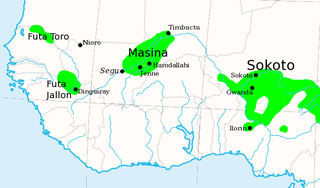
The Caliphate of Hamdullahi, commonly known as the Massina empire, was an early nineteenth-century Sunni Muslim caliphate in West Africa centered in the Inner Niger Delta of what is now the Mopti and Ségou Regions of Mali. It was founded by Seku Amadu in 1818 during the Fulani jihads after defeating the Bambara Empire and its allies at the Battle of Noukouma. By 1853, the empire had fallen into decline and was ultimately destroyed by Omar Saidou Tall of Toucouleur.
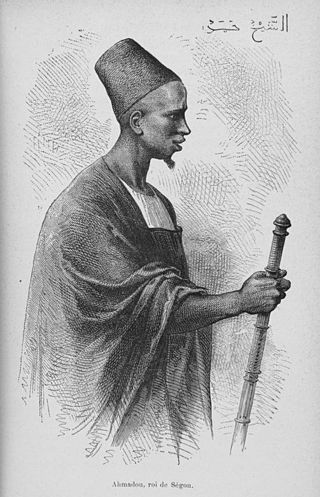
Ahmadou Sekou Tall was a Toucouleur ruler of the Toucouleur Empire (1864–93) and (Faama) of Ségou from 1864 to 1884.

Bitòn Coulibaly (1689?–1755), also known as Mamary Coulibaly, founded the Bambara Empire in what is now Mali's Ségou Region and Mopti Region.
Banamba is the capital of Banamba Cercle, one of the seven Cercles of the Koulikoro Region of Mali. Its estimated 2008 population is 7000. The town lies due north of the regional capital of Koulikoro, and is connected by a 40 km all-weather road via the town of Sirakorola, about halfway between the two. It is the location of the Lycée Franco-Arabe de Banamba.
Goundam is a commune and town in north central Mali, in the Tombouctou Region. It is the capital of Goundam Cercle, one of five subdivisions of the Region. In the 2009 census the commune had a population of 16,253. The main ethnic groups are Songhay, Tuareg and Fulani.

Articles related to Mali include:
The Battle of Ségou was a decisive point in the growth of the Toucouleur Empire (1850-1890), which spread throughout the upper Niger River and Senegal River bassins in the late 19th century. It marked the destruction of the last of the Songhay successor states, the beginning of El Hadj Umar Tall's conflict with fellow Fula Jihad leader of Macina, and a Toucouleur movement to the east under pressure from French Colonial expansion in the Senegambia.

Ségou Cercle is an administrative subdivision of the Ségou Region of Mali. The administrative center (chef-lieu) is the town of Ségou.
Nyamina is a small town and rural commune in the Cercle of Koulikoro in the Koulikoro Region of south-western Mali. The commune lies to the north of the Niger River and covers an area of 1,283 km2. It includes the town of Nyamina and 47 villages. In the 2009 census the commune had a population of 35,548. The town lies on the left bank of the river, 80 km northeast of Koulikoro.
Sansanding, sometimes called Sinsani, is a small town and rural commune in the Cercle of Ségou in the Ségou Region of southern-central Mali. The commune includes the town and 17 of the surrounding villages in an area of 315 square kilometers. In the 2009 census it had a population of 23,109. The town sits on the left (north) bank of the River Niger about 50 km downstream from Ségou.
